This is an image of Mars.
Click on image for full size
NASA/JPL
The Climate of Mars
The unusual climate of Mars makes Mars not quite right for life as we know it on Earth. If the climate were warm enough, water would not freeze into the ground but vaporize into the atmosphere. Lots of water vapor in the atmosphere would help keep Mars warm, and prevent water from freezing.
On a cold planet water can be frozen into the ground, like the frozen tundra of the Earth, and therefore trapped. This ground water can only be turned into running water when the climate of Mars undergoes a change.
Over the history of Mars, when the climate changes due to the unusual shape of its orbit, water, which has been stored, frozen, underground, turns to running water and is transferred from regions near the poles to regions near the equator. This phenomena has to do with the unusual global geography of Mars. Scientist think there are two possiblities for how it happens.
Ultimately, as Mars cools off, climate changes are not enough to prevent the water from being permanenty frozen into the ground.
You might also be interested in:

Just as Goldilocks found the porridge that was just right, the Earth seems to be just right for living creatures. The Earth seems to be the perfect distance from the sun for lots of water. Venus is too
...more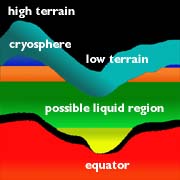
The drawing shows a crossection of the crust, and the unusual altitude variation of the Martian surface. The figure illustrates the depth of frozen ground at various latitudes, called the cryosphere. The
...more
The Martian climate is more influenced by the shape of the Martian orbit than the climate of the Earth is influenced by the shape of the Earth's orbit. The orbit of Mars is more oval-shaped than that
...more
On Mars, the water is trapped, frozen, within the ground. Nevertheless, there is evidence for running water on Mars. When the water is melted and released to the surface, it will run from higher ground
...more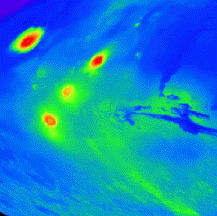
On this map of Mars, the lightly cratered Tharsis Ridge is shown, as well as the heavily cratered Martian highlands (near the bottom of the picture), and Valles Marineris to the right. The volcanoes are
...more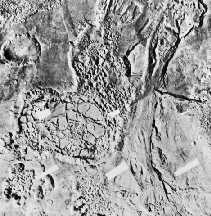
Separate from the Martian outflow channels, or the river valley networks, are large Martian lakes (600 km, or ~1000 miles across) which exhibit evidence of a periodic and catastrophic release of water
...more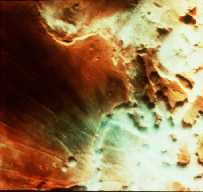
This is an image of fog in a Martian canyon. The presence of fog provides evidence of water, and a water cycle on Mars. More fog has been seen in images returned by Mars Global Surveyor of the south polar
...more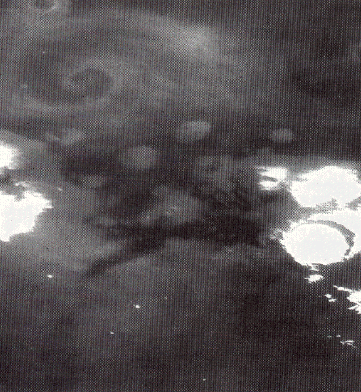
This is an image of a storm moving across the Martian terrain. The camera is looking down upon the storm and the storm front forms a spiral pattern, the same way terrestrial storms are presented on the
...more














